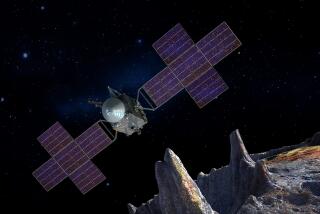The incredible journey of NASA spacecraft Dawn
- Share via
NASA’s pioneering Dawn spacecraft, a year late in being launched and 20% over budget, is slowly creeping up on the protoplanet Vesta and is expected to enter orbit around it about July 16, the first stop on a remarkable journey that will later take the craft to the larger dwarf planet Ceres.
The craft, the largest probe ever launched by NASA, is about half-way through its three-month approach phase to Vesta, 96,000 miles away and closing in at the sedate speed of about 260 mph.
The whole procedure is happening so slowly, in terms of normal asteroid flybys and planetary encounters, that scientists at the Jet Propulsion Laboratory in La Cañada Flintridge will not be able to calculate precisely when the craft entered orbit until after the fact.
The craft’s visit to Vesta will be the first prolonged encounter with an object in the main asteroid belt that lies between Mars and Jupiter and the first trip to a protoplanet, a large body that almost became a planet.
Both Vesta and Ceres are thought to have been formed when the solar system itself was being assembled from the dust that condensed into the sun and planets. Researchers once thought that both were remnants of a planet that formed and then was destroyed by a massive collision with a moon or some other object.
They now believe, however, that the asteroid belt contains the remnants of a planet whose formation was disrupted by the gravitational effects of nearby Jupiter. As such, its composition should mirror that of the earliest objects orbiting the sun.
“This tiny world … is a window into the early origin of the solar system and the terrestrial planets,” said Carol Raymond of JPL, deputy principal investigator for Dawn. Learning about it “will give us better tools to understand the thousands of fragments that are out there in the asteroid belt.”
Dawn was originally scheduled to launch in the summer of 2006, but testing problems with the engines delayed the launch until September 2007. Those problems also raised the cost of the mission from a planned $373 million to $446 million at launch.
Dawn is a unique craft and mission on a variety of accounts. For one, it is not powered by a conventional rocket engine but by three ion engines. Electrical fields produced by two 27-foot solar panels accelerate xenon ions to high speed, expelling them out the three engines and providing a thrust about the same as “a single piece of paper pressing down on your hand,” according to JPL’s Robert Mase, the Dawn project manager.
That may not seem like much, but by the time the craft has used up its load of 937 pounds of xenon, the engines will have provided 24,000 mph of velocity change.
NASA’s Deep Space 1 used similar technology in its 1999 mission to sweep by the asteroid Braille, where it produced disappointingly fuzzy images of the object — which some believe to have been ejected from Vesta.
Dawn, however, will go into orbit around Vesta and stay there for a year before climbing out of orbit and proceeding on to Ceres, which it is expected to reach in 2015. No spacecraft has accomplished such a feat before.
Its initial orbit around Vesta will be a little under 10,000 miles high, but it will spiral in, eventually getting as close as 120 miles above the surface, where it should produce breathtaking pictures of the craters. Spectrometers on the craft will also map minerals on the surface and in the craters, which should lead to a clearer picture of how Vesta formed.
Researchers are particularly interested in learning if Vesta has an iron core.
Actual science will begin in the second week of August, Mase said.
Vesta is a great big rock, about 359 miles by 348 miles by 285 miles. The only feature on it that can be discerned from Earth is a massive crater 285 miles across and eight miles deep.
Scientists think they already know a lot about the composition of Vesta. Over the years, repeated collisions with other asteroids have knocked off a lot of material that is floating between the Earth and Vesta. Gravitational interactions with Jupiter propel it toward Earth. An estimated one in every 20 meteorites that strike Earth originated on Vesta, according to UCLA’s Christopher Russell, Dawn principal investigator.
Researchers are perhaps even more eager to learn about Ceres. Recent research suggests that the 606-mile-wide dwarf planet may hold a buried ocean under a thick layer of ice. Some estimates suggest that Ceres might even have more water than Earth itself.
More to Read
Sign up for Essential California
The most important California stories and recommendations in your inbox every morning.
You may occasionally receive promotional content from the Los Angeles Times.









